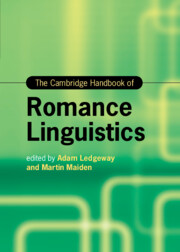Book contents
- The Cambridge Handbook of Romance Linguistics
- Cambridge Handbooks in Language and Linguistics
- The Cambridge Handbook of Romance Linguistics
- Copyright page
- Dedication
- Contents
- Figures
- Tables
- Contributors
- Abbreviations
- 1 Data, Theory, and Explanation: The View from Romance
- Part One What Is a Language?
- Part Two Phonetics and Phonology
- Part Three Morphology
- Part Four Syntax
- Part Five Semantics and Pragmatics
- Part Six Language, Society, and the Individual
- 27 Register, Genre, and Style in the Romance Languages
- 28 Contact and Borrowing
- 29 Diamesic Variation
- 30 Social Factors in Language Change and Variation
- Index
- References
28 - Contact and Borrowing
from Part Six - Language, Society, and the Individual
Published online by Cambridge University Press: 23 June 2022
- The Cambridge Handbook of Romance Linguistics
- Cambridge Handbooks in Language and Linguistics
- The Cambridge Handbook of Romance Linguistics
- Copyright page
- Dedication
- Contents
- Figures
- Tables
- Contributors
- Abbreviations
- 1 Data, Theory, and Explanation: The View from Romance
- Part One What Is a Language?
- Part Two Phonetics and Phonology
- Part Three Morphology
- Part Four Syntax
- Part Five Semantics and Pragmatics
- Part Six Language, Society, and the Individual
- 27 Register, Genre, and Style in the Romance Languages
- 28 Contact and Borrowing
- 29 Diamesic Variation
- 30 Social Factors in Language Change and Variation
- Index
- References
Summary
Language contact is at the base of potential changes in language, whose extent may vary considerably depending on the degree of multilingual interaction. Therefore, the study of language contact is key to the understanding of the evolutionary dynamics of language. The Romance linguistic landscape cuts across multiple possible contact-setting types, and the empirical evidence for contact-induced change involving Romance is abundant. The Romance languages thus qualify as an ideal testbed for language contact studies. This chapter highlights the difference between innovative and conservative effects of language contact and discusses borrowing as the fundamental process and result of contact-induced language change, distinguishing between RL and SL agentivity, and between matter borrowing and pattern borrowing. Several case studies of borrowing are presented in relation to different components of grammar, namely phonology, prosody, morphology, and syntax. The upper limits of borrowing are discussed (in terms of areal formation and mixed language genesis) and a number of predictors of grammatical borrowing are reviewed. Issues concerning the so-called borrowability hierarchies are critically addressed.
Keywords
- Type
- Chapter
- Information
- The Cambridge Handbook of Romance Linguistics , pp. 845 - 869Publisher: Cambridge University PressPrint publication year: 2022
References
Selected References
- 3
- Cited by

